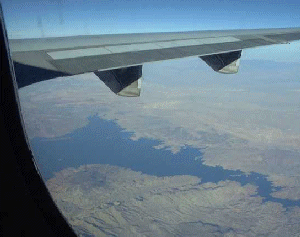Benjamin Franklin’s map of the Gulf Steam (A), which he made in 1770, and a recent NOAA satellite image of the Gulf Stream (B) in which differences in sea surface temperature are shown with different colors. Blues represent the coldest water while orange and yellow represents warmer water.
Click on image for full size
(A) The NOAA Photo Library and (B) NOAA
Picturing the Gulf Stream Current
Benjamin Franklin wondered why the boat carrying mail from North America to Europe was much faster than the boat carrying mail in the other direction. Ben Franklin was one of the people in charge of the American postal service and he was also a scientist. He used science to get to the bottom of this postal mystery.
At that time, letters and packages were taken across oceans by boats. The boats travelling from Europe to North America took weeks longer than mail boats heading in the opposite direction.
To solve the mystery, Ben Franklin spent lots of time in a boat taking temperature measurements and making other observations of the ocean. He discovered that an ocean current was to blame for the mail delay. Boats going to Europe were sped up by the current. Boats going to North America were slowed by the current. He called the current the Gulf Stream.
Ben Franklin made a map of the Gulf Stream in 1770. He noticed many features that made the Gulf Stream water different from the surrounding ocean. One of the most characteristic was a difference in temperature. The Gulf Stream water is warmer than the other ocean water that surrounds it.
The warmer water of the Gulf Stream shows up in satellite images too. Orange and red shows the warmest water and purple and blue shows the coldest water. The Gulf Stream is the warmest water in this satellite image. Benjamin Franklin used temperature measurements to find the ocean current.
Last modified September 18, 2008 by Lisa Gardiner.
You might also be interested in:

The water at the ocean surface is moved by powerful wind. The wind is able to move the top 400 meters of the ocean. This moving water is called surface ocean currents. Surface ocean currents form large
...more
The average temperature, precipitation, and winds at a location determine its regional climate. These average weather conditions are determined by factors including the latitude and altitude of the region,
...more
Looking for online content that can be used for a climate change education course or module? Pages linked below can be used to support an introductory climate change education for either a unit or a full
...more
An aquifer is the name for a layer of rock which is capable of holding a large amount of water. Some layers are better at holding water than others, for example a layer of sandstone can hold a good deal
...more
Limestone is an example of a carbonate. Other examples of carbonates include calcite, dolomite, and marble. Limestone dissolves easily in rainwater, especially rainwater which is loaded with carbonic acid.
...more
Have you ever left a glass of water out for a long time? Did you notice that the water disappears after a few days? That's because it evaporated! Evaporation is when water passes from a liquid to a gas.
...more
Rivers are very important to Earth because they are major forces that shape the landscape. Also, they provide transportation and water for drinking, washing and farming. Rivers can flow on land or underground
...more















